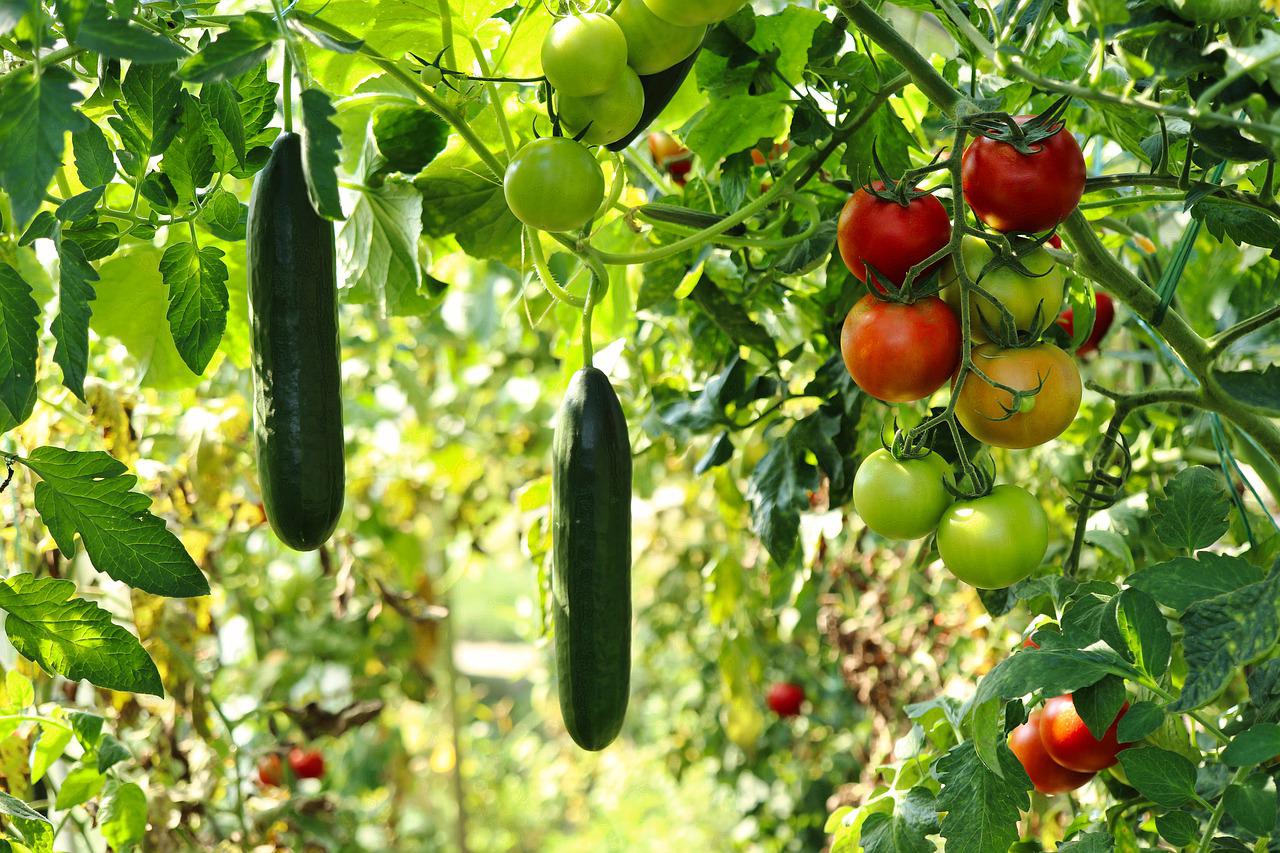17 Fruits and Vegetables You Can Grow Vertically
May, 2022 |Looking to create your own vertical vegetable garden? Growing your own fruits and vegetables is one of the most rewarding gardening experiences. And you don’t need acres of space to create a bountiful harvest.
You can pick basketfuls of berries and tonnes of tomatoes in a small garden or balcony. All by growing vegetables vertically using supports, frames, or specialized planters. It saves space, but it also has lots of other benefits too. Vertical gardening is quickly becoming one of the most popular garden styles for a small space.
Related Read | A Guide to Balcony Vegetable Gardening

Disclaimer: This post contains affiliate links. When you make a purchase through one of these links I may earn a commission. This comes at no extra cost to you.
The benefits of a vertical vegetable garden
Even in a medium-sized garden, growing fruits and vegetables vertically has plenty of benefits…
- Space-saving and maximizes the yield per cubic meter
- Easier to harvest
- Reduces the risk of some vegetable pests (slugs and snails)
- Also reduces the risk of some diseases
- It looks attractive
- It can also provide some privacy
Lots of vine vegetables are perfectly suited to growing up instead of out. Many members of the pea and gourd family are perfect for growing vertically as they like to climb. But there are also a few surprising vegetables that work well in a vertical vegetable garden.

Vegetables that grow vertically
So if you’re looking to turn your balcony or small garden into a productive vegetable garden, here are 17 vegetables you can grow vertically in your mini garden space!
1. Climbing Beans
A vegetable garden classic and one of the best crops for high yield harvests! Beans are easy to grow, often hardy, and you can pick them throughout the summer. You can add them to salads and side dishes or even dry them for use later in the year.
They’re a great source of protein for vegetarians and vegans, and satisfying to harvest! You can easily train them to climb a frame or bamboo teepee. These sturdy bamboo canes from Amazon are perfect for climbing beans.
Our favorite climbing bean varieties:
- Kentucky Wonder Beans: Popular heirloom pole bean.
- Benchmaster Runner Beans: A classic in English cottage gardens.
- Cobra French Beans: A popular stringless green bean.

2. Cordon Tomatoes
Tomatoes are usually available in either bush, trailing, or cordon varieties. Bush tomatoes can be kept quite slim, but cordon tomatoes are the best for growing tomatoes in a small space. This combined planter and trellis from Amazon is a great option for growing tomatoes vertically.

Cordon tomatoes can produce an abundance of tomatoes along their tall trailing stems. There are so many different cordon varieties to choose from, if you have the space we recommend growing at least two! Tomatoes are one of the most popular high yield crops you can grow.
Our favorite cordon tomato varieties:
- Sweet Million: Produces cascades of cherry-sized tomatoes.
- Rainbow Blend: Plum tomatoes that grow in a mix of yellows, oranges, and reds.
- Gardeners Delight: An old classic with fruits slightly bigger than cherry tomatoes.

3. Cucumbers
Like the tomato, cucumber is technically a fruit! They’re a refreshing summer favorite that works well in summer salads or as revitalizing eye masks. Cucumber vines are perfect for training up supporting poles and frames. This a-frame cucumber trellis from Amazon is a great option!
If you live in a cooler area, check out these cucumber varieties that are tolerant of cooler conditions.

4. Summer Squashes
Many squashes like Black Beauty zucchini or Pattypan squashes grow outwards from a central stem that creeps along the ground. However, these squashes can be trained to grow vertically. There are also other varieties that produce vines that are well suited to climb poles.
With thinner skin, summer squashes do not store as long as winter squashes, making them a perfect crop to enjoy throughout the summer. They are however one of the best high yielding crops, so you’re always guaranteed a good harvest with summer squashes!
Our favorite summer squash varieties:
- Black Forest Zucchini: A unique climbing zucchini
- Tromboncino: Climbing squash with a curved end
- Gourmet Gold: Yellow zucchini that could be trained up a pole

5. Winter Squashes
Winter squashes tend to grow more like a vine, meaning they’ll grow well up a frame or support. They produce little tendrils that will grab onto supports, but they may also need tying in.
As heavy squash fruits develop they may need a little extra support — even some mini winter squash varieties will need support. We cover heavy fruit ‘hammocks’ in our how to grow vertical veg guide.
This combined planter and trellis from Amazon is perfect for growing two winter squash vines vertically.
Some of our favorite winter squash varieties:
- Honeynut: Like a mini butternut squash, perfect for small spaces.
- Kabocha: Mini green squash, delicious when roasted.
- Spaghetti Squash: An unusual squash variety with spaghetti-like insides that can be used as a carb-free pasta alternative!
6. Pumpkins
Although technically a squash, pumpkins are usually divided into their own unique category. Just like winter squashes, pumpkins produce a vine that can climb up supports. Growing pumpkins vertically is a great space-saving method for small gardens as their long vines can quickly take up floor space.
Because pumpkins tend to be quite large, you might not be able to grow big ‘jack-o-lantern’ pumpkins vertically as the vine probably won’t support their weight. Luckily there is an amazing variety of mini pumpkin varieties for you to choose from.
Our favorite mini pumpkin varieties:
- Jack Be Little: A popular mini orange pumpkin with a 3-inch diameter.
- Small Sugar Pumpkin: Very popular for making pumpkin pie.
- Baby Boo: A small white pumpkin that’s popular for Halloween decor.
7. Peas
A real sweet treat in late spring and early summer, it’s hard to beat the taste of freshly picked peas. Like beans, peas are perfectly suited to climbing as they send out small tendrils that can grip supports. There are 3 different categories of peas: shelling (English), sugar (snow), and snap.
Dwarf peas are a particularly great vertical vegetable to grow with kids as the low-growing plants make it easier for them to pick the pods. You can easily create a mini DIY teepee using these bamboo canes from Amazon.
Our favorite climbing pea varieties:
- Sugar Daddy Snap: A stringless, dwarf pea variety, great in a stir fry.
- Alaska Shelling Pea: A sweet, early variety for shelling.
- Snow Max: Great to add whole pods into a stir fry.
8. Hops
Fancy brewing your own beer? The flowers on this climbing plant have been traditionally used for centuries to create beer. The US is currently the world’s biggest hop producer. Even if you don’t plan on creating a homebrew yourself, they can provide lovely leafy coverage on a pergola or trellis.

9. Nasturtiums
Nasturtiums have been loved by gardeners for their bold flowers and cascading growth. But they’re also well suited to climbing trellises and frames too. Plus, nasturtium flowers, young seeds, and leaves are edible too! Their peppery flavor works well in salads, pesto, sauces, and even as a spinach alternative.
They work well as trailing plants for hanging baskets, and are also great easy-to-grow flowers for children to grow in containers.

10. Sweet Potatoes
Sweet potatoes may not hang on vines like beans or squash, but their trailing stems can reach up to 5ft (1.5m) long! Instead of taking up all that precious garden space, you can train their lush foliage up a vertical support. You’ll still harvest the tubers that grow in the soil or container, but it’s a great way to enjoy sweet potatoes while saving space.
They usually prefer warmer climates, but there are new hardier varieties emerging that can thrive in cooler regions.
Our favorite sweet potato varieties:
- Georgia Jet: A hardy variety, great for the Northeast US and UK.
- Beauregard: Large, deliciously sweet, a sweet potato classic.


11. Melons
The taste of summer! Melons are a fantastic crop to grow in warmer areas. Although there are now some great cold tolerant melon varieties that thrive in cooler areas with shorter growing seasons too. Melons can be vulnerable to downy mildew, but growing them vertically helps to reduce the risk.
You can easily train their trailing vine up a trellis, but make sure to support any heavy fruits. Mini melon varieties are a great option to grow if space is really limited!
Our favorite climbing melon varieties:
- Super Ball Hybrid: A small variety, great for vertical growing.
- Blacktail Mountain: A classic watermelon, hardy, but fruits may need support.
- Sprite: Mini melons, about the size of a grapefruit!
- Sugar Cube Hybrid: A sweet-tasting mini cantaloupe.

12. Grapes
Grapes aren’t only for vast vineyards, they’re perfect for training up walls or pergolas. You can easily grow your own table or wine grapes, even in a small garden.
We often associate grapes with France and Italy, but there are some fantastic grape varieties native to North America. The key is to pick grape varieties that will match your climate. Check out these cold hardy grape varieties for USDA zones 6 and below.
This small metal archway from Amazon would look beautiful covered in a trailing grape vine!
Our favorite grape varieties:
- Fox Concord: Hardy US variety that’s great for making jams, jellies, and juice.
- Sangiovese: A popular red grape from Italy.
- Chardonnay: A popular white wine grape, great for growing on pergolas.

13. Strawberries
Strawberries may not produce long climbing shoots like the pea or bean plant. However, they can be stacked in alternating pots along a wall or placed in specialized vertical growing planters. As the fruits ripen they’ll hang down from their pots, instead of being scavenged by hungry insects on the ground.

14. Bottle Gourd
A vine plant with amazing history and cultural value, bottle gourds (often known as calabashes) were originally grown as a container to hold water. They’re still used today within many cultures around the world. Like melons, pumpkins, or squash, you can grow and prepare them as a vegetable. However, you can also dry them out and appreciate their use as a container.

15. Summer Berry vines
You can grow a huge variety of summer berries vertically. It’s just a case of choosing your favorite! Some of the most popular garden summer berries that grow on vines include:
- Blackberries
- Raspberries
- Loganberries
You could also grow some unusual fruits like gold raspberries. Berry vines usually like to grow and spread, but with pruning and maintenance, they can be tied to vertical supports. These bamboo canes from Amazon are all you would need to support these vines.
Raspberries and blackberries in particular can take over quickly. But by keeping them in a container you can manage the spread of their roots.

16. Passion Fruit
Mini, juicy fruits bursting with tropical flavor. Passionflower vines are perfectly suited to growing vertically as they like to climb.

There are lots of berry bushes suited to small spaces and fruit trees that you can grow in a small garden too, like blueberries, peaches, and apples.
You might like | How to Grow Apple Trees in a Small Garden
17. Cucamelon
Resembling a mini watermelon, these tiny fruits have a refreshing cucumber taste. Its other common names include ‘Mexican sour gherkin’ and ‘mouse melon’. As a vining plant, it’s perfectly suited to growing in a vertical vegetable garden!

Featured Image: by Alexander Fox | PlaNet Fox from Pixabay









